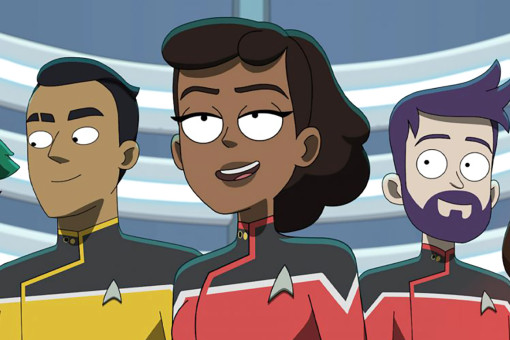Dr. Henry Louis Gates Jr. is on the Zoom to talk about his love of television. But because he’s a renowned historian, college professor, literary critic and Finding Your Roots host, Gates can’t help but start his Television Academy interview with a fascinating lesson about the subject at hand.
“You know, cable television was actually invented for people who lived in mountainous regions where a broadcast signal couldn’t get through,” he explains. “Young people, like my students, think it was invented for people living in New York City!” He adds that the service came to his small paper mill town of Piedmont, West Virginia, back in 1949, which meant he grew up sampling all nine available channels every day from “the time I woke up” through bedtime. “We could watch whatever people in Baltimore and Washington D.C. watched,” Gates notes, “So it cut down on this sense of being isolated in the hills.”
Gates, of course, is an expert on the past. In the eleventh season of the hit Finding Your Roots (premiering on PBS on January 7), he and his team use genealogical detective work and DNA analysis to trace the family trees of a new group of curious public figures. It turns out that Kristen Bell’s seventh great-grandfather spied for the British during the American Revolution, while her husband, Dax Shepard, is a descendent of French fur traders captured by the British during the War of 1812. Chrissy Teigen, he says, is the first person he’s ever found with ancestry to Roma gypsies.
Even after finding the roots of 300 guests since 2012, “I have never been bored once!” says Gates, also the Director of the Hutchins Center for African & African American Research at Harvard University. “I’m with these people for sometimes six hours doing the reveal so we build an intimate connection. It’s very emotional for them, and for me.”
For his My Seven Shows, Gates (call him “Skip”) unsurprisingly drew on his personal history. “When I sat down and made my list, I decided my most memorable shows are the ones that shaped me when I was young and still in school,” he says. (In fact, he says he’s thought about writing a book about television from 1950 through 1968.)
After winnowing down his favorites — and lamenting that he didn’t choose his beloved Star Trek — he gave his picks to the Television Academy.
Amos ‘N’ Andy (1951-53, CBS)
It was taken off the air because the NAACP thought it was perpetuating stereotypes of Black people. But what they were not subtle enough to understand was that these Black actors took racist caricatures from the radio program — which had been invented by two White guys playing Black characters in a Black dialect — and re-appropriated them. And they made them funny! It's maybe the all-time greatest Black sitcom in history. This was the first time I ever saw a Black doctor, a Black lawyer, a Black judge and a Black policeman directing traffic in Harlem.
One of the most popular episodes was set during Christmas ["The Christmas Story" from 1952]. Andy wants to get Amos' daughter, Arbadella, a Black doll that she sees in the department store. So he moonlights as Santa Claus at the department store in order to make enough money to buy this Black doll. It ends with Alvin Childress [who played Amos] reading the Lord's Prayer to his daughter, and the music comes up. It's so sentimental and you're just in tears.
Ding Dong School (1952-56, NBC)
This was a predecessor for Romper Room and Sesame Street. It was also the most important television show in the development of my personality. I watched it every morning, five days a week with my mother. It was the highlight of my day!
Frances Horwich — "Miss Frances" — from Chicago was the teacher, and she looked like a prototype of a grandmother. I loved that lady, and I was riveted to the TV. By the time I was three or four, I knew the alphabet. I could print all the letters and read basic children's books. So it prepared me for school and programmed me to love to read and write and learn. Miss Frances gets the No. 1 prize for me.
You Are There (1953-57, CBS)
I was born in 1950, so this made an impression on me from the time I was three. Walter Cronkite was the host, and he would reenact these great historical events. It was mostly from Western civilization, but I wouldn't expect them to be truly multicultural at that time. But it was riveting.
Being a cultural historian is one of my day jobs, and my love of history was birthed through Walter Cronkite. I don't understand why someone hasn't been clever enough to bring it back.
Topper (1953-55, CBS)
Leo G. Carroll played this banker [named Cosmo Topper] haunted by two ghosts who drank cocktails. Sometimes he would be so flummoxed that he would say, "Get away from me, get away from me." And Cosmo would be surrounded by all these [real] people, and they'd say, "Who are you talking to?"
The ghosts were played by Robert Sterling and Anne Jeffreys, who were so cool and sophisticated. They had a St. Bernard who carried a small barrel of alcohol around his neck — because, apparently, St. Bernards who went to rescue people in ski accidents in Switzerland would carry alcohol for medicinal purposes. I loved the whole idea of the show, and it took away my fear of ghosts!
Gunsmoke (1955-75, CBS)
Oh, I loved that James Arness was so cool and upstanding. He stood for law and order, and the bad guys always got what they deserve. He had a sidekick who was funny [Dennis Weaver's Chester Goode], and they were a great combination. The good guys were going to prevail in the Old West!
It ran for 20 years, but I went away to college at Yale in 1969 and there were no TVs allowed in the rooms. So Gunsmoke was my Saturday night show, and Bonanza was my Sunday night show. I loved the patriarch [Ben Cartwright, played by Lorne Greene] and the interaction of the three brothers, played by Pernell Roberts, Dan Blocker and Michael Landon. I loved the scenes with Michael Landon as Little Joe. He was always courting a woman.
The Avengers (1961-69, ITV and ABC)
This was a British show. The Avengers were detectives. Or they were like spies? But they were always involved in combating evil forces and using their wits and their elegance to do that.
Diana Rigg was so beautiful. She was like Catwoman before Catwoman! She wore these bodysuits and was so beautiful and so brilliant and so athletic. She would beat up the bad guys with jiu jitsu. I admired her very much. And I loved John Steed, who was played by Patrick Macnee. He was so immaculately dressed — he wore a derby hat and always had an umbrella. He drove an antique-looking sports car. I always wanted a car like that. And I always wanted to dress like John Steed — but I could do without the derby hat.
The Richard Pryor Show (1977, NBC)
Richard Pryor deserves a Nobel Prize because he was a genius in the history of both African American comedy and American stand-up comedy. [The Richard Pryor Show] was like a variety show with skits, but it wasn't on late night. It aired on Tuesday evenings. And you know how raw Richard Pryor was, so he had to dial it back.
But Richard Pryor did invent a conceit that is unique in the history of comedy, which is create a character as "a double self." His name was Mudbone, and he would talk to [Pryor]. It's like he split himself. So Mudbone would say things like "That Pryor boy is going to get in trouble. He's always out of control." These skits were ingenious.
Pryor finally got canceled because he appeared to be naked in a skit. He was really just wearing a brown body suit, but he knew he was pushing the boundary. Right after that, NBC canceled him. I was a young assistant professor at Yale at that point, and everybody I knew watched The Richard Pryor Show. We were sorry that there was nothing we could do to save it.
This interview has been edited and condensed for length and clarity.


















